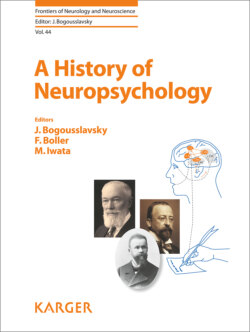Читать книгу A History of Neuropsychology - Группа авторов - Страница 60
На сайте Литреса книга снята с продажи.
Historical Background
ОглавлениеWhen he proposed the concept of Gogi syndrome, he cited semantic aphasia proposed by Head [11], or Namenaphasie by Kleist [12] or mixed transcortical aphasia by Goldstein [13] for discussion but did not identify it with them. Of these, Imura regarded Goldstein’s mixed transcortical aphasia most akin to Gogi aphasia [14]. Although Imura failed to mention, almost identical aphasic symptom complex had been reported by Arnold Pick in 1898 [15]. In this article, Pick introduced Arnaud’s contribution. According to Pick, this Arnaud described a type of transcortical aphasia he termed as “surdite verbale representative.” As the name suggests, this “representative verbal deafness” is characterized by good grasp of spoken word and inability to comprehend its meaning as if it were completely foreign. The patient would correctly repeat an incomprehensible word he just heard. It is not the problem of word sound reception, but the problem of understanding the sound as a symbol of concept. Pick himself described several cases of this type of aphasia. One of them (case F, 67-year-old female) grasped a word sound correctly and repeated the word consciously as if asking its meaning. For instance, she responded to a command to close her eyes, by repeating the word eyes: “What are eyes?” Likewise, to a command to bring a piece of soap, she questioned: “What is soap?”
The existence of Gogi aphasia has been repeatedly confirmed in Japan [8]. Unfortunately, this has not been the case in Europe and America. This may be due to the difference of the mode of spoken language. Indo-European languages belong to a group called reflected language, while Japanese is one of the agglutinated languages in which semanteme (substantive words) and morpheme (grammatical words) are clearly separated [4].
